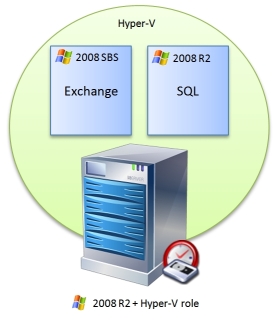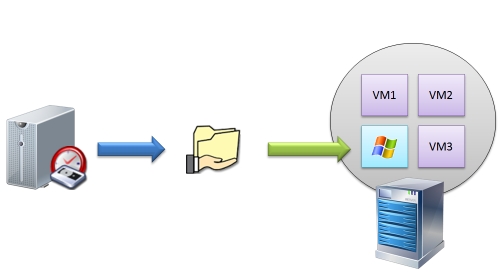One of the key benefits of using BackupAssist in a Hyper-V environment is that only one licence is required on the physical host server in order to perform file level backups across all of the guest machines.
In this post I’m going to step through a Hyper-V scenario I come across quite frequently, and show you how to configure a single backup job to provide the following:
- Bare metal backup
- Recovery of a guest machine in its entirety
- Recovery of files from a guest
- Exchange mailboxes and near-continuous SQL backup
For this scenario the following set of licences must be purchased for one installation of BackupAssist on the Hyper-V host server.
1 x BackupAssist with Upgrade Protection
1 X Hyper-V Granular Restore Console
1 x Exchange Mailbox add-on
1 x SQL add-on
Scenario 1 – Server configuration
In this example I’ll be backing up a single 2008 Hyper-V server running two 2008 guests.
VM 1 - 2008 SBS including Exchange
VM 2 - 2008 Server R2 with SQL
 Last week Neil and I traded our keyboards and mice for a transit van filled with exhibition equipment, half a tonne of assorted promotional items and a rainy afternoon on the M4. Our mission, to capture the attentions of a good chunk of the 12,500 attendees to InfoSecurity Europe and talk to them about our core products, BackupAssist, MailStore and MDaemon.
Last week Neil and I traded our keyboards and mice for a transit van filled with exhibition equipment, half a tonne of assorted promotional items and a rainy afternoon on the M4. Our mission, to capture the attentions of a good chunk of the 12,500 attendees to InfoSecurity Europe and talk to them about our core products, BackupAssist, MailStore and MDaemon.


 We're but a few weeks away from the annual industry pilgrimage to Earls Court for the biggest of the IT and security shows in this country,
We're but a few weeks away from the annual industry pilgrimage to Earls Court for the biggest of the IT and security shows in this country, Over the past few years we've used a variety of different virtualisation tools but have historically always stuck to a mixture of either VMWare tools (esxi, Player and Workstation) or Microsoft’s Hyper-V platform.
These have worked really well for building larger virtual server platforms but recently I was looking for a quick and easy to configure tool that I could use on my own desktop PC. I was just looking to build some simple test machines for evaluating software in a range of scenarios.
After some browsing I came across
Over the past few years we've used a variety of different virtualisation tools but have historically always stuck to a mixture of either VMWare tools (esxi, Player and Workstation) or Microsoft’s Hyper-V platform.
These have worked really well for building larger virtual server platforms but recently I was looking for a quick and easy to configure tool that I could use on my own desktop PC. I was just looking to build some simple test machines for evaluating software in a range of scenarios.
After some browsing I came across 
 We were recently asked if you could recover a Windows Image Backup of a 2008 R2 server taken with
We were recently asked if you could recover a Windows Image Backup of a 2008 R2 server taken with